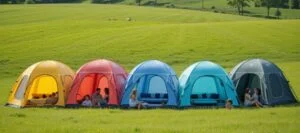When planning a camping trip, your tent is one of the most important investments you’ll make. It’s not just a shelter; it’s your home away from home. With so many options available, finding the right tent for your camping style can be overwhelming. This guide will help you navigate through the key considerations to ensure your tent is perfect for your needs.
1. Understand Your Camping Style
Before you start shopping, think about how you camp. Your camping style determines the type of tent you’ll need. Consider the following:
- Backpacking: If you’re hiking long distances, prioritize lightweight and compact tents.
- Car Camping: For those who drive to their campsite, weight isn’t as critical, so you can opt for larger, more comfortable tents.
- Family Camping: Choose tents with multiple rooms and plenty of space to accommodate everyone.
- Solo Adventures: A small, easy-to-setup tent might be all you need.
Your style influences not only size and weight but also the features and durability of the tent.
2. Choose the Right Tent Size
Tent size is crucial for comfort and practicality. Tents are often categorized by the number of occupants they can accommodate, but these measurements can be misleading. Always consider:
- Space Needs: A two-person tent might fit two people snugly but leave little room for gear. If you want extra space, consider sizing up.
- Ceiling Height: If you want to stand or move around easily, look for tents with higher ceilings.
- Floor Space: Check the dimensions to ensure there’s enough room for sleeping bags, gear, and movement.
Pro Tip: Bring a tape measure when tent shopping and visualize how your gear and companions will fit inside.
3. Consider Tent Shape and Design
Different tent shapes offer unique advantages. The most common designs include:
- Dome Tents: Easy to set up and great for general camping. They’re lightweight and perform well in wind and rain.
- Cabin Tents: Ideal for families or groups, offering vertical walls and ample standing room.
- Tunnel Tents: Provide excellent space-to-weight ratios, ideal for backpackers.
- A-Frame Tents: Classic and simple, but less spacious than modern designs.
Choose a shape that complements your camping activities and the environment you’ll be in.
4. Material Matters
The materials used in a tent impact its durability, weather resistance, and weight. Pay attention to these key components:
- Fabric: Nylon is lightweight and durable, while polyester resists UV rays better. Canvas offers superior insulation but is heavy.
- Poles: Aluminum poles are lightweight and sturdy, while fiberglass is more affordable but less durable.
- Floor: Look for thick, waterproof flooring to prevent water seepage.
Pro Tip: Check for a denier rating (D) on the fabric. Higher numbers indicate thicker, more durable materials.
5. Weather Resistance
Your tent’s ability to handle weather conditions is vital. Consider:
- Seasons: Choose between 3-season and 4-season tents. Three-season tents are lighter and suitable for spring, summer, and fall, while four-season tents are built to withstand harsh winter conditions.
- Rainfly: A full-coverage rainfly offers better protection against rain and wind than a partial one.
- Ventilation: Ensure your tent has mesh panels and vents to reduce condensation.
If you’re camping in unpredictable weather, invest in a tent with a high waterproof rating and reinforced seams.
6. Ease of Setup
Nobody wants to struggle with a complicated tent setup after a long day. Look for:
- Freestanding Tents: These are easy to pitch and can be moved without disassembly.
- Color-Coded Poles: Simplifies the process, especially for beginners.
- Pop-Up Tents: Convenient for quick setups but may lack durability.
Read reviews or watch videos to gauge how straightforward the setup process is.
7. Additional Features
Modern tents come with an array of features to enhance your camping experience. Some extras to consider include:
- Vestibules: Provide storage space for gear outside the sleeping area.
- Interior Pockets: Help organize small items like flashlights and phones.
- Multiple Doors: Prevents climbing over others during nighttime bathroom trips.
- Windows: Allow for natural light and ventilation.
Pro Tip: Make a list of must-have features before you start shopping to avoid being overwhelmed by options.
8. Budget Considerations
Your budget will play a significant role in the tent you choose. High-quality tents can be expensive, but they often offer better durability and features. To get the most value:
- Compare Brands: Look for reliable brands known for quality camping gear.
- Shop Off-Season: Prices tend to drop after the summer camping rush.
- Read Reviews: Learn from other campers’ experiences to avoid costly mistakes.
Investing in a well-made tent can save you money in the long run by reducing replacements and repairs.
Explore More Tent Options for Your Camping Style
When choosing a tent, it’s essential to match it with your camping needs and environment. If you’re planning a trip with the family, you’ll want a spacious and comfortable setup. Check out our guide on the Best Family Camping Tents: Spacious Options for Any Budget to find the perfect fit.
For backpackers prioritizing lightweight gear, understanding the differences between ultralight and traditional tents can help you make the best choice. Don’t miss our comparison in Ultralight vs Traditional Tents: Which Is Right for Your Needs to balance weight and durability on your adventures.
Conclusion
Choosing the perfect tent for your camping style requires careful consideration of your needs, the environment, and your budget. By focusing on size, materials, weather resistance, and features, you can find a tent that enhances your outdoor adventures.
Remember, the best tent isn’t necessarily the most expensive—it’s the one that fits your unique camping style and provides comfort and reliability when you need it most. Happy camping!
Reviewed and updated on 01/24/2025




